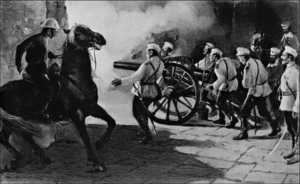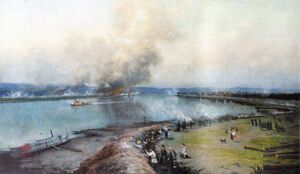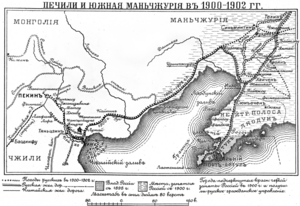الغزو الروسي لمنشوريا
| Russian invasion of Manchuria | |||||||
|---|---|---|---|---|---|---|---|
| جزء من تمرد الملاكمين | |||||||
 القوات الروسية تقتحم بوابات بكين 1900 | |||||||
| |||||||
| المتحاربون | |||||||
|
|
| ||||||
| القادة والزعماء | |||||||
|
|
| ||||||
| القوى | |||||||
| 100,000 Russian Army soldiers and Cossacks[1][2] | Manchu Bannermen, Boxers, Honghuzi bandits | ||||||
| الضحايا والخسائر | |||||||
| 242 killed, 1,283 wounded (per Russian sources)[1] | Unknown, at least in the thousands[1] | ||||||
The Russian invasion of Manchuria occurred in the aftermath of the First Sino-Japanese War (1894–1895) when concerns regarding China's defeat by the Japanese and the latter's occupation of Manchuria caused the Russians to speed up their long held designs for imperial expansion across Eurasia.
With the building of the South Manchuria Railway, Mukden (now known as Shenyang), which was occupied after the Boxer Rebellion,[3][4] became a Russian stronghold. As with all other major powers in China, Russia demanded concessions along with the railroad.
During the Boxer Rebellion, Russia became involved due to its presence in the foreign legations. Russian Cossacks formed part of the Eight Nation Alliance relief forces during the Seymour and Gaselee expeditions while Russian forces were also present inside the legations during the sieges in Beijing and Tianjin. These forces operated separately from those involved in the invasion of Manchuria, with the entire operation exclusively directed by Russians.
الحملة
The Russians invaded Manchuria during the rebellion, which was defended by Manchu bannermen. The bannermen were annihilated as they fought to the death against the Russians, each falling one at a time against a five pronged Russian invasion. The Russian anthropologist Sergei Mikhailovich Shirokogorov reported that the Russians killed many of the Manchus, thousands of them fled south. The Cossacks looted their villages and property and then burnt them down.[5][6] Manchuria was completely occupied after the fierce fighting that occurred.[7]
هجمات الملاكمين على السكة الحديدية الشرقية الصينية
The Boxers attacks on the Chinese Eastern Railway during the Boxer Rebellion took place in 1900. In response Russia invaded Manchuria.
Chinese Imperial troops engaged in attacks against Russians, in one incident, Chinese troops killed a cossack.[8] Another 15 Russian casualties occurred when Chinese cavalry attacked the Russians.[9] The Boxers destroyed railways and cut lines for telegraphs. The Yen-t'ai coal mines were burned by Chinese forces.[10]
The Chinese used arson to destroy a bridge carrying a railway and a barracks in the 27th of July.[11]
The Boxers destroyed railways in Manchuria in a strategic manouevre to halt enemy soldiers from moving. Imperial edicts were posted which called for attacks against the Russians, the stations of the South Manchuria Railway came under Boxer control.
With the building of the South Manchurian Railway, Mukden became a Russian stronghold, which occupied it after the Boxer Rebellion.[3][4]
After Russia invaded with regular troops, the railway came under Russian control again.[بحاجة لمصدر]
Defence of Yingkou
The Battle of Yingkou was a battle where Chinese forces battled against the invading Russian army in the Boxer Rebellion. Unlike the battles in China proper during the Boxer Rebellion, battles between Chinese and foreigners in Manchuria were exclusively between Chinese and Russians. The Russians were the sole force attacking Yingkou, at the time one of the main sea ports of Manchuria.[12]
Yingkou was divided into a foreign settlement and a Chinese city. Mishchenko had to engage his reserved troops to win the fight. When the Russians seized the city, a number of Boxers and Chinese Imperial troops managed to pull off an evacuation. A combination of a moat, precipitation, and mud hampered the movement of Russian troops and their guns.[13]
معركة پاي-تو-تزو
The Battle of Pai-t'ou-tzu (Pinyin: Baitouzi) was an engagement during the Boxer Rebellion between regular Chinese Imperial forces and an outpost of Russian infantry located in Chinese territory. Even before the Boxer rising against foreign influence, an outpost of Russian troops had been located across the Chinese border near the village of Pai-t'ou-tzu, which lay close to Liaoyang. It was garrisoned by 204 Russian troops under Colonel Mishchenko. When hostilities began, the Chinese authorities advanced a guarantee of safe passage in exchange for his retreat to the south of Liaoyang. This was declined, and instead Mishchenko called for more Russian troops to reinforce his position.[14]
Before the Russian position could be reinforced, fighting broke out. During the opening stages of the ensuing battle, Chinese guns bombarded the Russian right and front flanks, resulting in 14 Russian deaths and 5 wounded. Firing from long range at high trajectories, the Chinese artillery hit their marks, but at closer range proved inaccurate. Chinese regular infantry armed with rifles advanced, crawling under cover artillery fire towards the Russian defense perimeter of about 350 square feet. When the Russian fire slackened the Chinese troops renewed their attack. Chinese forces alternated between advance and retreat until the Russian position was over-run. Losses on both sides are uncertain but the Russian detachment may have been wiped out.[15]
المعارك على نهر آمور

The Battles on the Amur River were border clashes between Chinese Imperial Army troops along with Boxers against Russian forces who aimed for control over the Amur River for navigation.[16]
The Chinese summoned all available men to fight, and the Chinese forces and garrisons gathered artillery and bombarded Russian troops and towns across the Amur. Despite the Cossacks repulsing Chinese army crossings into Russia, the Chinese army troops increased the amount of artillery and kept up the bombardment. In revenge for the attacks on Chinese villages, Boxer troops burned Russian towns and almost annihilated a Russian force at Tieling.[17][18]
Russian governor K. N. Gribsky ordered Cossacks to destroy all Chinese posts on Amur river, and Cossacks completed the order during July. On July 20, Russian forces (including 16 infantry companies, a hundred Cossacks and 16 cannons) crossed the Amur near Blagoveshchensk with support from the steamers Selenga and Sungari. On July 20, Russian troops captured Saghalien; on July 22, Aigun.[بحاجة لمصدر]
After the victory over the Chinese forces, the general-governor of Amur Region, Nikolai Grodekov, decided to annex the right bank of the Amur River, and sent a telegram to St. Peterburg, but Russian Minister of War Aleksey Kuropatkin forbade such an action:
Because of restoring the good relation with China in the nearest future, His Majesty decided not to annex any part of China
Russian Invasion of Northern and Central Manchuria
The Crushing of Boxers in Northern and Central Manchuria was the invasion of the 100,000 strong Russian Army of Manchuria. These events form part of the period known as the Boxer Rebellion.
On June 29 (1900), the first Russian force—two rifle regiments and some Cossacks from Khabarovsk—crossed the Chinese border, followed by units from Blagoveshchensk, Nikolsk-Ussuriski, and other towns.[1]
The campaign in Manchuria was conducted by both the regular Imperial army, including Manchu Bannermen and Imperial Chinese troops, and the Boxers.
The Russians invaded Manchuria during the rebellion, which was defended by Manchu bannermen. The bannermen were annihilated as they fought to the death against the Russians, each falling one at a time against a five pronged Russian invasion. The Russians killed many of the Manchus, thousands of them fled south. The Russian Cossacks looted some of their villages and property and then burnt them to ashes, but as revenge, the Chinese Boxers and Imperial army came to a large Russian village and killed many civilians and looted and burnt all their houses as revenge and killed many Russian defenders.[19][20] Manchuria was partially occupied after the fierce fighting that occurred.[7]
الأعقاب
By November 1900 most of Manchuria was secured by the Russian forces. War Minister General Kuropatkin reported that Russian losses were 22 officers and 220 men killed, along with 60 officers and 1223 men wounded. No records exist for Chinese losses, but estimates put them at much higher than Russian casualties. Lieutenant General Nikolai Linevich, for example, gave orders to destroy towns and execute Chinese in retaliation for attacks on the Russian railway in Manchuria. This policy was later changed and at least eight Cossacks were executed by hanging by a military court for crimes against civilians.[1]
Many Manchu Bannermen supported the Boxers and shared their anti-foreign sentiment.[21] The German Minister Clemens von Ketteler was assassinated by a Manchu.[22] Manchu bannermen had been devastated in the First Sino-Japanese War in 1895 and Banner armies were destroyed while resisting the invasion. In the words of historian Pamela Crossley, their living conditions went "from desperate poverty to true misery."[23] When thousands of Manchus fled south from Aigun during the fighting in 1900, their cattle and horses were stolen by Russian Cossacks who then burned their villages and homes to ashes.[24] The clan system of the Manchus in Aigun was obliterated by the despoliation of the area at the hands of the Russians.[25]
Much of the fighting in the Boxer Rebellion against the foreigners in defense of Beijing and Manchuria was done by Manchu Banner armies, which were destroyed while resisting the invasion. The German Minister Clemens von Ketteler was assassinated by a Manchu.[26] Manchu banner garrisons were annihilated on 5 roads by Russians as they suffered most of the casualties. Manchu Shoufu killed himself during the battle of Peking and the Manchu Lao She's father was killed by western soldiers in the battle as the Manchu banner armies of the Center Division of the Guards Army, Tiger Spirit Division and Peking Field force in the Metropolitan banners were slaughtered by the western soldiers. Baron von Ketteler, the German diplomat was murdered by Captain Enhai, a Manchu from the Tiger Spirit Division of Aisin Gioro Zaiyi, Prince Duan and the Inner city Legation Quarters and Catholic cathedral were both attacked by Manchu bannermen. Manchu bannermen were slaughtered by the Eight Nation Alliance all over Manchuria and Beijing because most of the Manchu bannermen supported the Boxers in the Boxer rebellion.[27] The clan system of the Manchus in Aigun was obliterated by the despoliation of the area at the hands of the Russian invaders.[28] There were 1,266 households including 900 Daurs and 4,500 Manchus in Sixty-Four Villages East of the River and Blagoveshchensk until the Blagoveshchensk massacre and Sixty-Four Villages East of the River massacre committed by Russian Cossack soldiers.[29] Many Manchu villages were burned by Cossacks in the massacre according to Victor Zatsepine.[30]
Sergei Witte advised the Tsar to withdraw Russian forces from Manchuria, but Kuropatkin advocated for a continued Russian presence in Manchuria. The Russians tried to secure agreements favorable to themselves in exchange for withdrawal, but China refused.[31][32]
The Honghuzi continued to plague Manchuria despite multiple attempts aiming for their eradication and mass killings directed at them by Cossack forces. They were enlisted by the Japanese during the Russo-Japanese War to attack the Russians on their rear.[بحاجة لمصدر]
الحرب الروسية اليابانية
Japan was angered that Russia had not withdrawn according to the treaty it signed in the Boxer Protocol in which it promised to withdraw from Manchuria.[بحاجة لمصدر]
انظر أيضاً
المراجع
 هذه المقالة تتضمن نصاً من The Century illustrated monthly magazine, Volume 68، وهي مطبوعة من سنة 1904 وهي الآن مشاع عام في الولايات المتحدة.
هذه المقالة تتضمن نصاً من The Century illustrated monthly magazine, Volume 68، وهي مطبوعة من سنة 1904 وهي الآن مشاع عام في الولايات المتحدة. هذه المقالة تتضمن نصاً من The Century: a popular quarterly, Volume 68، بقلم Making of America Project، وهي مطبوعة من سنة 1904 وهي الآن مشاع عام في الولايات المتحدة.
هذه المقالة تتضمن نصاً من The Century: a popular quarterly, Volume 68، بقلم Making of America Project، وهي مطبوعة من سنة 1904 وهي الآن مشاع عام في الولايات المتحدة. هذه المقالة تتضمن نصاً من Appletons' annual cyclopaedia and register of important events، وهي مطبوعة من سنة 1901 وهي الآن مشاع عام في الولايات المتحدة.
هذه المقالة تتضمن نصاً من Appletons' annual cyclopaedia and register of important events، وهي مطبوعة من سنة 1901 وهي الآن مشاع عام في الولايات المتحدة.
- ^ أ ب ت ث ج Pronin, Alexander (7 November 2000). Война с Желтороссией (in روسية). Kommersant. Retrieved 6 July 2018.
- ^ Jukes, Geoffrey (2014-06-06). "Introduction". The Russo-Japanese War 1904–1905 (in الإنجليزية). Bloomsbury Publishing. ISBN 978-1-4728-1003-8.
- ^ أ ب The Century illustrated monthly magazine, Volume 68. NEW YORK: The Century Co. 1904. p. 581. Retrieved 2011-07-06.(Original from Harvard University)
- ^ أ ب Making of America Project (1904). The Century: a popular quarterly, Volume 68. NEW YORK: Scribner & Co. p. 581. Retrieved 2011-07-06.(Original from the University of Michigan)
- ^ Rhoads, Edward J. M. (2001). Manchus & Han: Ethnic Relations and Political Power in Late Qing and Early Republican China, 1861-1928 (reprint, illustrated ed.). University of Washington Press. p. 72. ISBN 0-295-98040-0. Retrieved 2010-06-28.
- ^ Shirokogorov, Sergey (1924). Social organization of the Manchus: A study of the Manchu clan organization. Vol. 3 of Publications, Royal Asiatic Society of Great Britain and Ireland North-China Branch. the University of Michigan: Royal Asiatic Society. p. 4. Retrieved 2011-06-01.
- ^ أ ب Frederick Converse Beach, George Edwin Rines (1912). The Americana: a universal reference library, comprising the arts and sciences, literature, history, biography, geography, commerce, etc., of the world, Volume 18. Scientific American compiling department. Retrieved 2010-06-28.
- ^ Wait, Eugene M. (2003). Imperialism. Nova History Publications. p. 406. ISBN 1-59033-664-X. Retrieved 2010-11-28.
- ^ Lensen, George (1967). The Russo-Chinese War. Diplomatic Press. p. 50. Retrieved 2010-11-28.
- ^ Lensen, George (1967). The Russo-Chinese War. Diplomatic Press. p. 14. Retrieved 2010-11-28.
- ^ Lensen, George (1967). The Russo-Chinese War. Diplomatic Press. p. 14. Retrieved 2010-11-28.
- ^ Lensen, George (1967). The Russo-Chinese War. Diplomatic Press. p. 55. Retrieved 2010-11-28.
- ^ Wait, Eugene M. (2003). Imperialism. Nova History Publications. p. 431. ISBN 1-59033-664-X. Retrieved 2010-11-28.
- ^ Lensen, George (1967). The Russo-Chinese War. Diplomatic Press. p. 18. Retrieved 2010-11-28.
- ^ Lensen, George (1967). The Russo-Chinese War. Diplomatic Press. p. 24. Retrieved 2010-11-28.
- ^ Lensen, George (1967). The Russo-Chinese War. Diplomatic Press. p. 160. Retrieved 2010-11-28.
- ^ Appletons' annual cyclopaedia and register of important events. D. Appleton. 1901. p. 105. Retrieved 2010-06-28.
- ^ Appletons' annual cyclopaedia and register of important events. D. Appleton. 1901. p. 106. Retrieved 2010-06-28.
- ^ Edward J. M. Rhoads (2001). Manchus & Han: Ethnic Relations and Political Power in Late Qing and Early Republican China, 1861-1928. University of Washington Press. p. 72. ISBN 0-295-98040-0. Retrieved 2010-06-28.
- ^ Shirokogorov, Sergey (1924). Social organization of the Manchus: A study of the Manchu clan organization. Royal Asiatic Society. p. 4. Retrieved 2011-06-01.
- ^ Crossley 1990, p. 174.
- ^ Rhoads 2000, p. 72.
- ^ Hansen, M.H. (2011). Lessons in Being Chinese: Minority Education and Ethnic Identity in Southwest China. University of Washington Press. p. 80. ISBN 9780295804125. Retrieved 18 June 2017.
- ^ Shirokogorov 1924, p. 4.
- ^ Chang 1956, p. 110.
- ^ Rhoads 2000, p. 72.
- ^ Rhoads, Edward J. M. (2017). Manchus and Han: Ethnic Relations and Political Power in Late Qing and Early Republican China, 1861-1928. Studies on Ethnic Groups in China. University of Washington Press. p. 72. ISBN 978-0295997483.
- ^ Chang & University of Washington. Far Eastern and Russian Institute 1956, p. 110.
- ^ 俄罗斯帝国总参谋部. 《亚洲地理、地形和统计材料汇编》. 俄罗斯帝国: 圣彼得堡. 1886年: 第三十一卷·第185页 (俄语).
- ^ Higgins, Andrew (March 26, 2020). "On Russia-China Border, Selective Memory of Massacre Works for Both Sides". The New York Times.
- ^ March, G. Patrick (1996). Eastern destiny: Russia in Asia and the North Pacific (illustrated ed.). Greenwood Publishing Group. p. 180. ISBN 0-275-95566-4. Retrieved 2011-07-29.
- ^ Westwood, J. N. (1986). Russia against Japan, 1904-1905: a new look at the Russo-Japanese War. SUNY Press. p. 20. ISBN 0-88706-191-5. Retrieved 2011-07-29.
